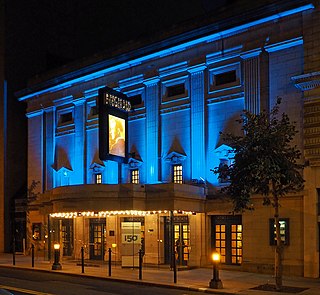
The Fitzgerald Theater is the oldest active theatre in Saint Paul, Minnesota, and the home of American Public Media's Live from Here. It was one of many theaters built by the Shubert Theatre Corporation, and was initially named the Sam S. Shubert Theater. It was designed by the noted Chicago architectural firm of Marshall and Fox, architects of several theaters for the Shuberts. In 1933, it became a movie outlet known as the World Theater. The space was purchased by Minnesota Public Radio in 1980, restored with a stage in 1986 as a site for Prairie Home, and renamed in 1994 after St. Paul native F. Scott Fitzgerald.
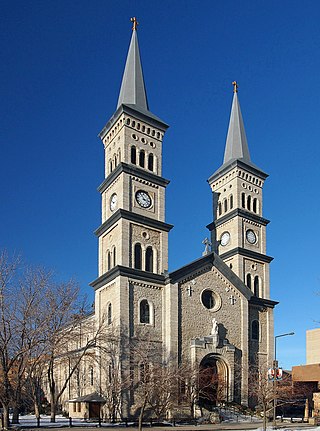
The Church of the Assumption Catholic Church was dedicated in 1874 and is the oldest existing church in Saint Paul. It is located at 51 West Seventh Street, in downtown Saint Paul. The building is listed on the National Register of Historic Places.

The Pilgrim Baptist Church located at 732 Central Avenue West in Saint Paul in the U.S. state of Minnesota is the building that houses the first Black Baptist congregation in Saint Paul. The congregation was founded on November 15, 1866, by Reverend Robert Hickman and a group of escaped slaves from Boone County, Missouri. They were smuggled up the Mississippi River on the steamer War Eagle with the help of Union Soldiers and the Underground Railroad. The current building, which is listed on the National Register of Historic Places, was built in 1928.
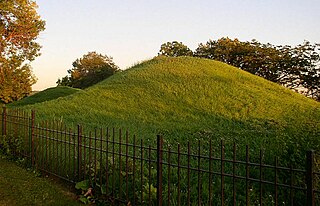
Dayton's Bluff is a neighborhood located on the east side of the Mississippi River in the southeast part of the city of Saint Paul, Minnesota which has a large residential district on the plateau extending backward from its top. The name of the bluff commemorates Lyman Dayton, for whom a city in Hennepin County was also named. On the edge of the southern and highest part of Dayton's Bluff, in Indian Mounds Park, is a series of seven large aboriginal mounds, 4 to 18 feet high, that overlook the river and the central part of the city.
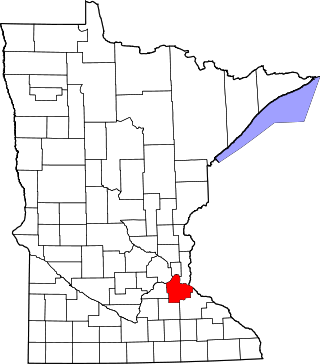
This is a list of the National Register of Historic Places listings in Dakota County, Minnesota. It is intended to be a complete list of the properties and districts on the National Register of Historic Places in Dakota County, Minnesota, United States. Dakota County is located in the southeastern part of the U.S. state of Minnesota, bounded on the northeast side by the Upper Mississippi River and on the northwest by the Minnesota River. The locations of National Register properties and districts for which the latitude and longitude coordinates are included below, may be seen in an online map.

The Exchange Bank Building was built in 1880 as the most prominent commercial building in Farmington in the U.S. state of Minnesota. It is the city's second-oldest commercial building. The Italianate and Romanesque brick building is located at 320 Third Street and was designed by Saint Paul's Augustus Gauger.

The Church of Saint Mary's is a 1909 Beaux-Arts Catholic church, located at 8433 239th Street East, New Trier in the U.S. state of Minnesota. The bright red building sits high on a hill overlooking the town, which was settled by German immigrants from Trier. The immigrants began arriving in 1854, and in 1857, they built a log church. In 1864, they built a larger stone church on a hill above the town.
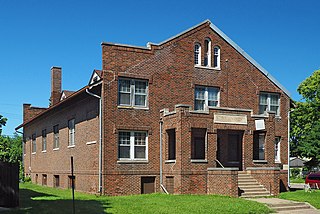
The Serbian Home is a two-story brick building, that was built in 1924 in South Saint Paul in the U.S. state of Minnesota. It was built as a community center for Serbian immigrants who worked in the meatpacking industry. It served as a museum respecting the multitude of ethnic groups who have made the city their home until 2020, when it was purchased and renovated by Serbian immigrant Aleksandar Stojmenovic to serve as an event center.

St. Stefan's Romanian Orthodox Church is a historic church built in 1924 in South St. Paul, Minnesota, United States. It was built for Romanian American immigrants who worked in the meatpacking industry. It continues to serve as a Romanian Orthodox Church.
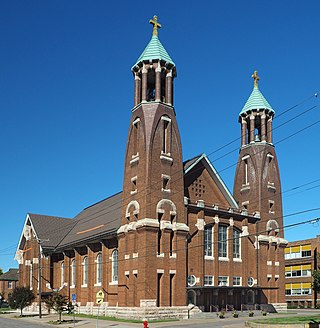
The Church of Saint Bernard is a Roman Catholic parish in the North End neighborhood of Saint Paul, Minnesota. The brick church was designed by John Jager and built 1905–1914 in the Prairie School and Art Nouveau styles. It is listed on the National Register of Historic Places.

The Church of Saint Casimir is a Roman Catholic church building built in 1904 in the Beaux-Arts style in Saint Paul, Minnesota, United States. It is listed on the National Register of Historic Places. The church was founded to serve the needs of Polish American immigrants.

The Otto W. Rohland Building is a historic building in Saint Paul, Minnesota, United States. Otto Rohland immigrated from Germany in 1867; this Victorian shop/residential building was built in 1891 and served as Rohland's grocery store and meat market into the 1950s; one source says the market was at 461 Old Fort Road.

The Pioneer and Endicott Buildings are two office buildings located in downtown Saint Paul, Minnesota, United States. The 1890-built Endicott building forms an L-shape around the 1889-built Pioneer Building. At its completion, the Pioneer building was the tallest in Saint Paul. The Endicott building was designed by Cass Gilbert and James Knox Taylor; the Pioneer Building was designed by Solon Spencer Beman in the Romanesque style; it was the first building in the United States to have a glass elevator. Connected in the 1940s, they are together listed in the National Register of Historic Places. The Pioneer Building was the tallest building in Saint Paul, Minnesota from its construction in 1889 until 1915 when the Cathedral of St. Paul was constructed. It surpassed the Globe Building.

The Minnesota Boat Club Boathouse on Raspberry Island is a historic structure in Saint Paul, Minnesota, United States. It is the home of the Minnesota Boat Club, a rowing club founded in 1870, that is Minnesota's oldest athletic organization. In 1885, a wooden structure was built on Raspberry Island to house the Minnesota Boat Club. The club constructed a new boathouse in 1910, which was designed by George H. Carsley in the style of Mission Revival architecture. The boathouse building was listed on the National Register of Historic Places in 1982.
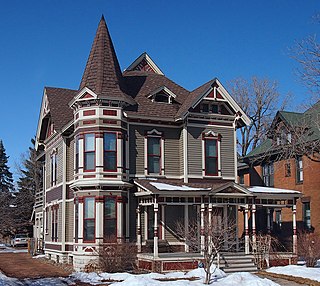
The Adolf Muench House is listed on the National Register of Historic Places in Saint Paul, Minnesota, United States. The 1884 house designed by Emil W. Ulrici overlooks Saint Paul from the bluffs east of downtown.

The Vienna and Earl Apartment Buildings are Neo-Classical Revival residences, built and designed in 1907 by Louis F. Lockwood and Carl P. Waldon, located 2 blocks north of Summit Avenue in Saint Paul, Minnesota. The buildings are Registered Historic Places.

This is a list of the National Register of Historic Places listings in Carver County, Minnesota. It is intended to be a complete list of the properties and districts on the National Register of Historic Places in Carver County, Minnesota, United States. The locations of National Register properties and districts for which the latitude and longitude coordinates are included below, may be seen in an online map.

Edward Payson Bassford (1837–1912) was an architect who practiced in St. Paul, Minnesota, in the late 19th century. Born in Calais, Maine, on June 7, 1837, he moved to St. Paul in 1866. He worked in the office of Abraham Radcliffe for a time, then founded his own architectural firm. By the 1870s, Bassford was the busiest architect in St. Paul, working on designs for houses, schools, and many commercial buildings. His firm also employed architects who later were famous in their own right, such as Cass Gilbert, Augustus Gauger, Edward J. Donohue, Silas Jacobson, and Charles Bassford. He died in Osakis, Minnesota, on July 20, 1912.

Frederick Carl Eberley was a prominent architect in Denver, Colorado. His work included the Barth Hotel (1882). He is also credited with Kopper's Hotel and Saloon, also known as the Airedale Building, added to the National Register of Historic Places in 1999. Eberley lived in the Schulz-Neef House, built in 1881 at 1739 E. 29th Avenue, for a time after German immigrant R. Ernst Schulz, a bookkeeper at the German National Bank and real estate investor for whom it was built. Eberley later lived at 29th Avenue and Gilpin Street. Eberley was a German immigrant and his commission for the Kopper's Hotel and Saloon came from a fellow German immigrant. His other work includes Colorado State Armory, Blatz Brewery, Colorado Bakery & Saloon, and Groussman Grocery.





















